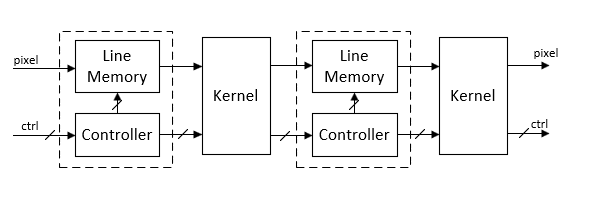Grayscale Closing
Morphological closing of grayscale pixel data
Libraries:
Vision HDL Toolbox /
Morphological Operations
Description
The Grayscale Closing block performs morphological dilation followed by morphological erosion by using the same neighborhood for both calculations. The block operates on a stream of pixel intensity values. You can specify a neighborhood or structuring element of up to 32-by-32 pixels.
For line, square, or rectangle structuring elements more than 8 pixels wide, the block uses the Van Herk algorithm to find the maximum and minimum pixel values. For structuring elements less than 8 pixels wide, or that contain zero elements, the block implements a pipelined comparison tree to find the maximum and minimum pixel values.
Ports
This block uses a streaming pixel interface with a
pixelcontrol bus for frame control signals. This interface enables the
block to operate independently of image size and format. All Vision HDL Toolbox™ blocks use the same streaming interface. The block accepts and returns a scalar
pixel value and a bus that contains five control signals. The control signals indicate the
validity of each pixel and its location in the frame. To convert a frame (pixel matrix) into a
serial pixel stream and control signals, use the Frame
To Pixels block. For a full description of the interface, see Streaming Pixel Interface.
Input
Output
Parameters
Tips
When you use a block with an internal line buffer inside an Enabled Subsystem (Simulink), the enable signal pattern must maintain the timing of the pixel stream, including the minimum blanking intervals. If the enable pattern corrupts the timing of the pixel stream, you might see partial output frames, corrupted pixel stream control signals, or mismatches between Simulink® and HDL simulation results. You may need to extend the blanking intervals to accommodate for cycles when the enable is low. For more information, see Configure Blanking Intervals.
Algorithms
Extended Capabilities
Version History
Introduced in R2016aSee Also
Grayscale Dilation | Grayscale Erosion | Closing (Computer Vision Toolbox) | Frame To Pixels | visionhdl.GrayscaleClosing
Topics
- Types of Morphological Operations (Image Processing Toolbox)
- Structuring Elements (Image Processing Toolbox)
